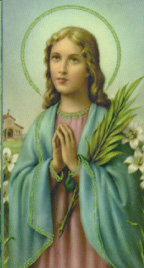We ask you, urgently: don't scroll past this
Dear readers, Catholic Online was de-platformed by Shopify for our pro-life beliefs. They shut down our Catholic Online, Catholic Online School, Prayer Candles, and Catholic Online Learning Resources essential faith tools serving over 1.4 million students and millions of families worldwide. Our founders, now in their 70's, just gave their entire life savings to protect this mission. But fewer than 2% of readers donate. If everyone gave just $5, the cost of a coffee, we could rebuild stronger and keep Catholic education free for all. Stand with us in faith. Thank you.Help Now >
Diocese of Pistoia and Prato
FREE Catholic Classes
(PISTORIENSIS ET PRATENSIS)
Located in the Province of Florence. The city of Pistoia is situated at the foot of the Apennines in the valley of the Ombrone. The chief industries of the town are the manufacture of paper and objects in straw. The cathedral dates from the fifth century, but was damaged by fire several times prior to the thirteenth century, when Nicolò Pisano designed its present form; the outer walls are inlaid with bands of black and white marble; the tribune was painted by Passignano and by Sorri; the paintings by Alessio d'Andrea and by Buonaccorso di Cino (1347), which were in the centre aisle, have disappeared. Other things to be admired, are the ancient pulpit, the cenotaphs of Cino da Pistoia and Cardinal Forteguerri, by Verrocchio, the altar of S. Atto, with its silver work, the baptismal font by Ferrucci, and the equipments of the sacristy. Opposite the cathedral is S. Giovanni Rotondo, the former baptistery ; it is an octagonal structure, the work of Andrea Pisano (1333-59), with decorations by Cellino di Nese; the font itself is a square base with four wells, surmounted by a statue of St. John the Baptist by Andrea Vaccà. The church of S. Giovanni Fuoricivitas is surrounded, on the upper part, by two rows of arches ; it is a work of the twelfth century; within, there is the pulpit, with its sculptures by Fra Gulielmo d'Agnello, and the holy-water font, representing the theological virtues, by Giovanni Pisano. The name of Pistoia appears for the first time in history in connexion with the conspiracy of Catiline (62 B. C. ), but it was only after the sixth century that it became important; it was governed, first, by its bishops, later by stewards of the Marquis of Tuscany. It was the first to establish its independence, after the death of Countess Matilda, and its municipal statutes are the most ancient of their kind in Italy. It was a Ghibelline town, and had subjugated several cities and castles; but, after the death of Frederick II, the Florentines compelled it to become Guelph. About 1300, the Houses of the Cancellieri (Guelphs), and Panciatichi (Ghibellines), struggled with each other for supremacy. The former having triumphed it soon divided into Bianchi and Neri, which made it easy for Castruccio Castracane to subject the town to his domination, in 1328. Florence assisted the Pistoians to drive Castruccio from their town, but that aid soon weighed upon them, and they revolted (1343), taking part with Pisa. In 1351 Pistoia became definitively subject to Florence. Clement IX was a Pistoian.
PRATO is also a city in the Province of Florence, situated in the fertile valley of the Bisenzio, which supports many industries, among them flour mills, woolen and silk manufactories, quarries, iron, and copper works. The Cicognani college of Prato is famous. The cathedral, which was erected before the tenth century, was restored in the thirteenth and fourteenth centuries, according to plans of Giovanni Pisano; it contains paintings by Fra Filippo Lippi and by Gaddi, a pulpit that is a masterpiece of Donatello, and the mausoleums of Carlo de'Medici and of Vincenzo Danti. In the chapel of la Cintola there is preserved a girdle that, according to the legend, was given by Our Lady to St. Thomas. Pinto is first mentioned in history, in 1007, as being in rebellion against Florence; after that it had several wars with Florence and Pistoia. In 1350, it was bought by the Florentines, to prevent it from falling into the hands of the Visconti. In 1512, it was sacked by the Spaniards. Fra Arlotto, author of the first Biblical concordance, was a native of Prato, as were also Fra Bartolommeo della Porta and several personages of the Inghirami family. Pistoin claims to have received the Gospel from St. Romulus, the first Bishop of Fiesole. The first mention of a Bishop of Pistoia is in 492, though the name of this prelate, like that of another Bishop of Pistoia, referred to in 516, is unknown. The first historically known bishop is Joannes (700); Leo (1067), important in the schism of Henry IV ; Jacobus (1118-41); the Blessed Atto (1135-53); Bonus (1189), author of "De cohabitatione clericorum et mulierum"; the Ven. Giovanni Vivenzi (1370); Matteo Diamanti (1400); Donato de'Medici (1436) Nicolò Pandolfini (1475), who later became a cardinal ; three Pucci, Cardinal Lorenzo (1516), Cardinal Antonio (1519) and Roberto (1541); Alessandro de'Medici (1573) became Leo XI. In 1653, Prato was made a diocese, and united, œque principaliter , with Pistoia; as early as 1409, Florence asked for the creation of a diocese at Pinto, on account of the dissensions of the collegiate church of Pinto with the Bishops of Pistoia; and in 1460, it had been made a prelatura nullius , and given, as a rule, to some cardinal, in commendam . Other bishops of these sees were the Ven. Gerardo Gerardi (1679-90), under whom Prato founded its seminary ; Leone Strozza (1690), Abbot of Vallombrosa, founded the seminary of Pistoia, enlarged by Michele C. Visdomini (1702); Scipione Ricci (1780), famous on account of the Synod of Pistoia which he convened in 1786, and which Pius VI afterwards condemned. The diocese is a suffragan of Florence; has 194 parishes, with 200,100 inhabitants, 5 religious houses of men, and 19 of women, and 7 educational establishments for girls.
Join the Movement
When you sign up below, you don't just join an email list - you're joining an entire movement for Free world class Catholic education.
-

- Easter / Lent
- Ascension Day
- 7 Morning Prayers
- Mysteries of the Rosary
- Litany of the Bl. Virgin Mary
- Popular Saints
- Popular Prayers
- Female Saints
- Saint Feast Days by Month
- Stations of the Cross
- St. Francis of Assisi
- St. Michael the Archangel
- The Apostles' Creed
- Unfailing Prayer to St. Anthony
- Pray the Rosary
One Nation Under God
Pope Leo XIV to Celebrate First-Ever “Mass for the Care of Creation”
Catholic Online AI Open Letter
Daily Catholic
 Daily Readings for Sunday, July 06, 2025
Daily Readings for Sunday, July 06, 2025 St. Maria Goretti: Saint of the Day for Sunday, July 06, 2025
St. Maria Goretti: Saint of the Day for Sunday, July 06, 2025 Prayer to the Holy Trinity: Prayer of the Day for Sunday, July 06, 2025
Prayer to the Holy Trinity: Prayer of the Day for Sunday, July 06, 2025 Daily Readings for Saturday, July 05, 2025
Daily Readings for Saturday, July 05, 2025 St. Anthony Mary Zaccaria: Saint of the Day for Saturday, July 05, 2025
St. Anthony Mary Zaccaria: Saint of the Day for Saturday, July 05, 2025- A Prayer for those who are preparing Children for their First Holy Communion: Prayer of the Day for Saturday, July 05, 2025
![]()
Copyright 2025 Catholic Online. All materials contained on this site, whether written, audible or visual are the exclusive property of Catholic Online and are protected under U.S. and International copyright laws, © Copyright 2025 Catholic Online. Any unauthorized use, without prior written consent of Catholic Online is strictly forbidden and prohibited.
Catholic Online is a Project of Your Catholic Voice Foundation, a Not-for-Profit Corporation. Your Catholic Voice Foundation has been granted a recognition of tax exemption under Section 501(c)(3) of the Internal Revenue Code. Federal Tax Identification Number: 81-0596847. Your gift is tax-deductible as allowed by law.



 Daily Readings for Sunday, July 06, 2025
Daily Readings for Sunday, July 06, 2025 St. Maria Goretti: Saint of the Day for Sunday, July 06, 2025
St. Maria Goretti: Saint of the Day for Sunday, July 06, 2025 Prayer to the Holy Trinity: Prayer of the Day for Sunday, July 06, 2025
Prayer to the Holy Trinity: Prayer of the Day for Sunday, July 06, 2025 St. Anthony Mary Zaccaria: Saint of the Day for Saturday, July 05, 2025
St. Anthony Mary Zaccaria: Saint of the Day for Saturday, July 05, 2025

